Gene editing is a great example of an extremely difficult concept that’s easy to understand. The recipe of life is DNA. Changing the recipe of life allows you to fix defects or create new and exciting things. Understanding the technical details of how that happens isn’t necessary to understand the value proposition, and screening the 27 gene editing stocks out there seems manageable.
Programming software is also an exceptionally complicated domain that can be difficult to understand based on the problems it’s trying to solve. The emergence of software-as-a–service (SaaS) business models means that you can compare and contrast various businesses using common metrics without having to understand what they do. On a spectrum of understandable SaaS firms, you might put DocuSign (DOCU) on the “easier” side and Alteryx (AYX) on the “harder” side. Generally speaking, we’re trying to avoid harder to understand businesses because they’re less accessible for retail investors.
Whether you analyze companies for a living or you’re a weekend warrior, it shouldn’t be difficult to figure out what any given company does. Here’s what you need:
- Latest investor deck
- Latest financial filing – 10-Q or 10-K
- Quarterly or annual earnings deck
- Transcript of latest earnings call
After reviewing these artifacts for Twilio (TWLO), we still didn’t have an intuitive understanding of what they do.
About Twilio Stock
Understanding a company is not about parroting their buzzwords in hopes that someone else can find meaning in them. With Twilio, it’s a buzzword extravaganza. The company’s mission is to “unlock the imagination of builders.” We always thought construction workers were quite creative thinkers, but perhaps not.
A FAQ that appears to be produced by a competent developer does a great job describing how the company works. The internet isn’t connected to the thousands of telecom providers spread across the planet’s 194 countries. Twilio does the hard work of providing a bridge between the carriers and the internet per the below diagram.
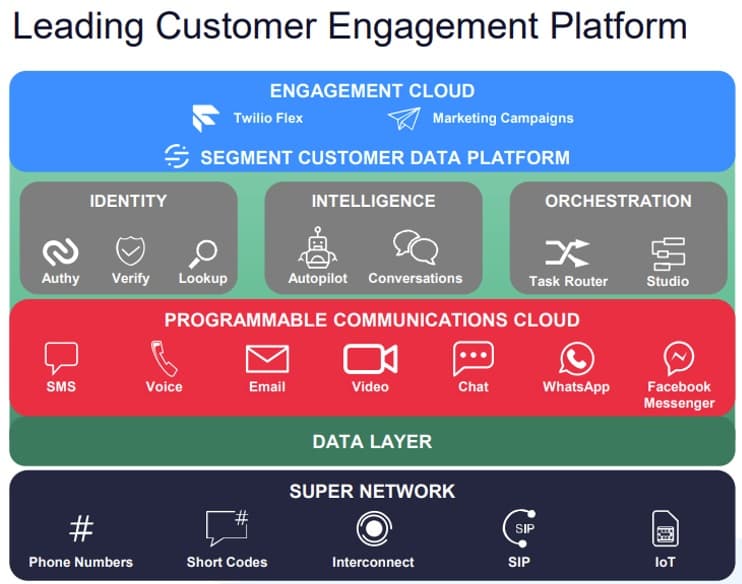
Companies need to communicate with their customers, and popular methods of communication will differ by country and include methods such as:
- Local phone numbers in 194 countries – SMS, Voice
- Communication apps: Whatsapp, FB Messenger, Viber, KakaoTalk, LINE, Telegram, etc.
- Email, chatbots, etc.
Twilio provides the infrastructure platform that lets developers embed communication capabilities into applications seamlessly. Here’s how we would describe what Twilio does in a concise manner.
Helping companies communicate with customers across all channels in a personalized manner.
A more official name for what Twilio offers is Communications Platform as a Service (CPaaS), and Statista places Twilio in the lead for this category with a 38% market share as of Q2-2021 with IDC also reporting Twilio as having a similar leadership position.
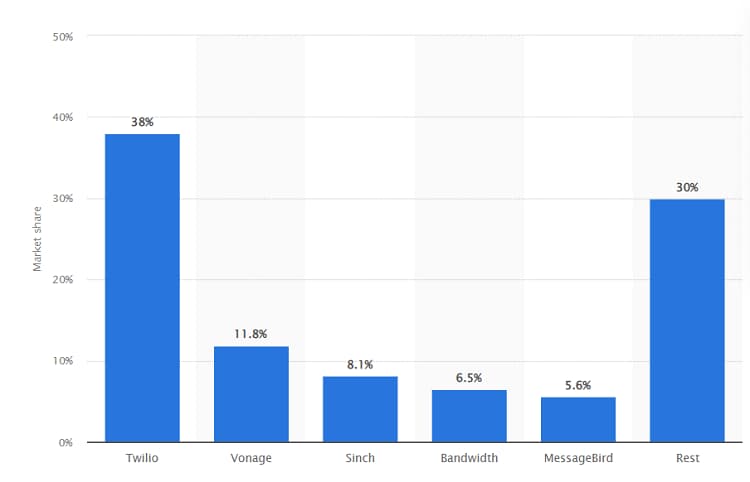
However, when you look through Gartner’s relevant Magic Quadrants such as Unified Communication as a Service, Twilio is nowhere to be found. Perhaps that’s because their platform applications have become too broad as result of all the acquisitions that have been made to expand the capabilities of their core platform.
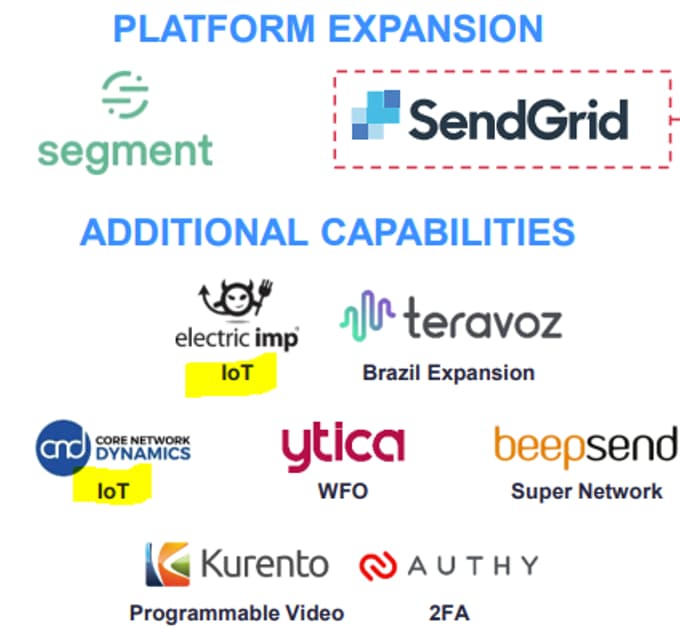
The SendGrid acquisition expanded Twilio’s email capabilities, while the Segment acquisition allows for personalized communication. The end result is a $13 billion company with $5 billion of goodwill on their balance sheet. As we saw with Teladoc and Livongo, having a large balance of goodwill on the balance sheet can be problematic.
Companies are moving to digitize their communication platforms and reduce costs. In an environment where getting contract signatures is becoming exceeding difficult, there’s an appeal to an offering that starts at $5 a month and then goes upwards from there based on usage. Intuitively, Twilio’s platform seems resilient in the face of today’s bear market. Companies will always need to communicate with their customers, and once they’ve embedded Twilio into their applications, switching to another vendor could be difficult. While net retention rate appears to be on the decline, it’s still healthy at above 120%, which means existing customers are spending more over time.
Companies of all sizes use Twilio to communicate with their customers, and they’re managing to increase spend across various revenue buckets with seven customers paying more than $10 million a year as of Q2-2020.

That’s the last time the company updated their investor deck, and next month’s investor day should refresh these metrics. The intermittent presentation of investor decks is characteristic of a firm that doesn’t do a very good job when it comes to investor relations. For example, the below three charts all refer to “Messaging” in a different context which makes it quite difficult to figure out what “Messaging” actually means.
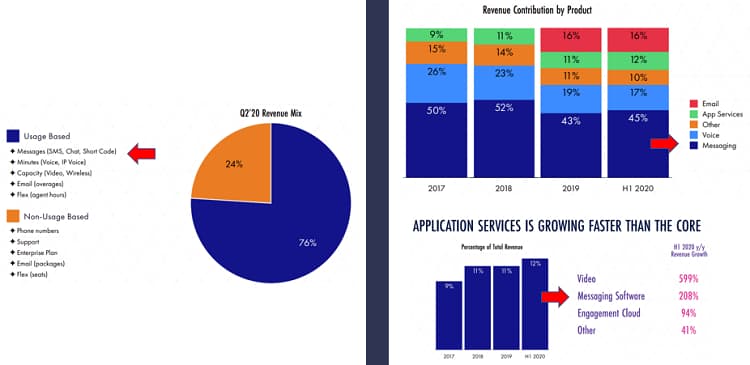
There is usage-based messaging, then the messaging revenue segment, then messaging software that’s under the “Apps” revenue segment that’s grown 208% year-over-year, a number that means little without a baseline. The below chart shows their net retention rate over time, and appears to use a scale that minimalizes the impact of the decline.
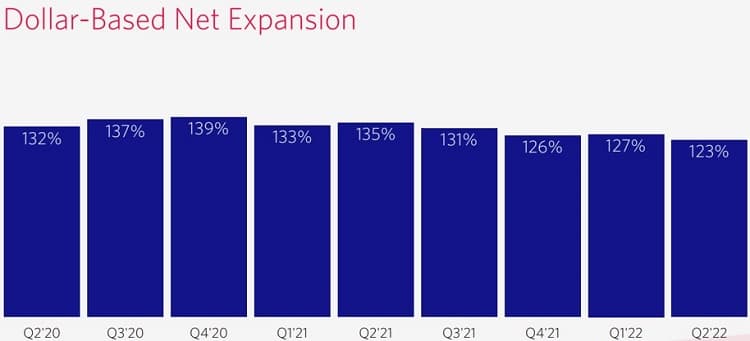
Maybe those efforts could have gone into explaining why customers are spending less over time. It’s really no surprise though that Twilio’s revenue growth is lagging, because macroeconomic headwinds have been affecting all SaaS companies across the board.
Going Long Twilio Stock
If you’re thinking about going long Twilio, there’s no better time. Shares have risen +56% since their IPO compared to a Nasdaq return of +156%. That means the firm has underperformed the market while revenue growth has climbed upwards steadily. With a simple valuation ratio of three, it’s hardly considered overvalued relative to other SaaS firms. Our main point of contention surrounds the difficulty in understanding the value proposition following their acquisitions.
It seems like the core platform suffers from lower margins, so Twilio is adding on capabilities – apps as they’re called – which offer a much higher margin.
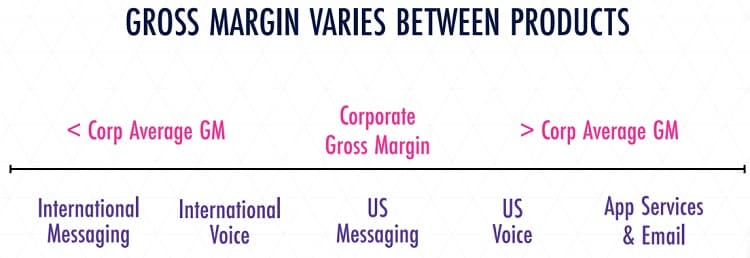
In 2021, Twilio’s gross margin was nearing 50%, so not half bad. At the same time, they’re burning through a mountain of cash – $500 million in the first half of this year alone. With $3.5 billion in cash on their books (net of nearly $1 billion debt), the company has a runway of about 3.5 years.
There are many components to the Twilio offering of which we don’t have any insights. For example, they talk about an IoT offering that was borne from the acquisitions of Electric Imp and Core Network Dynamics. How’s that coming along? To find out the current health of any product offering, you’d probably need an analyst to spend half a day poring through their collateral. The intermittent investor day decks don’t appear cohesive, and the earnings decks are rather sparse.
We came away from this research piece feeling like we still don’t have a sufficient understanding of Twilio’s value proposition, or what barriers to entry exist preventing companies like Cisco from encroaching on their turf. The acquisition spree makes their value proposition more complex, and the way they present this information in their sporadic investor decks doesn’t help. We don’t invest in companies we don’t fully understand, so we’ll be avoiding Twilio going forward.
Conclusion
A common response to a bear thesis is the accusation of the critic “not understanding the business.” If you need someone to explain a business model to you, that’s probably not a good investment to make. We spent an entire day analyzing Twilio’s business model and we have more questions than answers. This isn’t a company that any retail investor could easily understand, and investing in such businesses means we need to spend a great deal of time trying to figure out how the company is progressing. As Warren Buffet would say, only invest in businesses you fully understand.
Tech investing is extremely risky. Minimize your risk with our stock research, investment tools, and portfolios, and find out which tech stocks you should avoid. Become a Nanalyze Premium member and find out today!

















